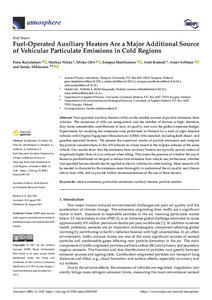Fuel‐operated auxiliary heaters are a major additional source of vehicular particulate emissions in cold regions
Karjalainen, Panu; Nikka, Markus; Olin, Miska; Martikainen, Sampsa; Rostedt, Antti; Arffman, Anssi; Mikkonen, Santtu (2021-09)
Karjalainen, Panu
Nikka, Markus
Olin, Miska
Martikainen, Sampsa
Rostedt, Antti
Arffman, Anssi
Mikkonen, Santtu
09 / 2021
1105
Julkaisun pysyvä osoite on
https://urn.fi/URN:NBN:fi:tuni-202109247256
https://urn.fi/URN:NBN:fi:tuni-202109247256
Kuvaus
Peer reviewed
Tiivistelmä
Fuel‐operated auxiliary heaters (AHs) can be notable sources of particle emissions from vehicles. The emissions of AHs are unregulated, and the number of devices is high; therefore, they make considerable contributions to local air quality, and even the global emissions budget. Experiments for studying the emissions were performed in Finland for a total of eight selected vehicles with Original Equipment Manufacturer (OEM) AHs installed, including both diesel‐ and gasoline‐operated heaters. We present the numerical results of particle emissions and compare the particle concentrations in the AH exhaust to values found in the tailpipe exhaust of the same vehicle. Our results show that the emissions from auxiliary heaters are typically several orders of magnitude higher than of a car exhaust when idling. This raises the question of whether the use of heaters is justified based on the goal to reduce total emissions from vehicle use; furthermore, whether fuel-operated heaters should also be applied in electric vehicles for cabin heating. More research will be needed to characterize the emissions more thoroughly to understand the air quality and climate effects from AHs, and to provide further recommendations on the use of these heaters.
Kokoelmat
- TUNICRIS-julkaisut [16944]
